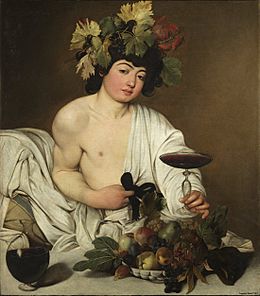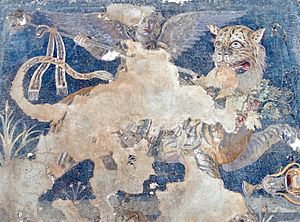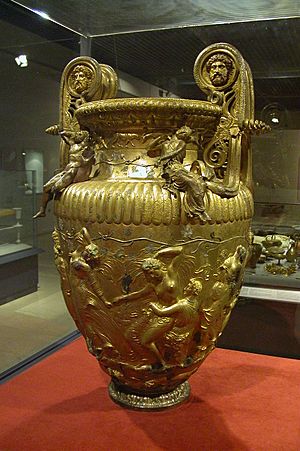Dionysian Mysteries facts for kids

The Dionysian Mysteries were a ritual of ancient Greece and Rome. It provided some liberation for men and women marginalized by Greek society, among which were slaves, outlaws, and non-citizens.
The original rite of Dionysus (as introduced into Greece) is associated with a wine cult.
Origins
The Dionysian Mysteries of mainland Greece and the Roman Empire are thought to have evolved from a more primitive initiatory cult of unknown origin (perhaps Thracian or Phrygian) which had spread throughout the Mediterranean region by the start of the Classical Greek period. Its spread was associated with the dissemination of wine. Beginning as a simple rite, it evolved quickly within Greek culture into a popular mystery religion, which absorbed a variety of similar cults (and their gods) in a typically Greek synthesis across its territories; one late form was the Orphic Mysteries. However, all stages of this developmental spectrum appear to have continued in parallel throughout the eastern Mediterranean until late in Greek history and forcible Christianization.
Rites

The rites were based on a seasonal death-rebirth theme, common among agricultural cults such as the Eleusinian Mysteries. The Osirian Mysteries paralleled the Dionysian, according to contemporary Greek and Egyptian observers. Spirit possession involved liberation from civilization's rules and constraints. It celebrated that which was outside civilized society and a return to primordial nature.
See also
 In Spanish: Misterios dionisíacos para niños
In Spanish: Misterios dionisíacos para niños
- Anthesteria, Ascolia, Dionysia, and Lenaia
- Ancient Greece and wine
- Ancient Rome and wine
- Bacchanalia and Liberalia
- Dionysus Cup, painted Attic drinking cup
- Greco-Roman mysteries
- Hellenistic religion
- Maiuma (festival) dedicated to Dionysus and Aphrodite
- Theatre of Dionysus in Athens
- Tyrnavos, Greek town and famous carnival venue


